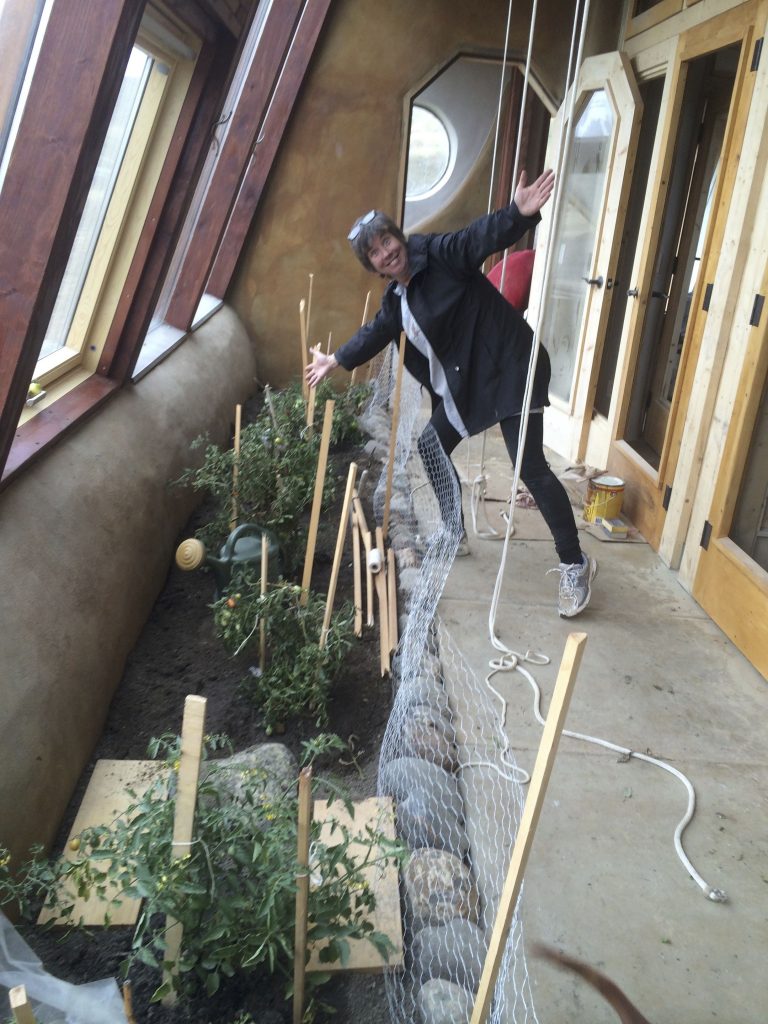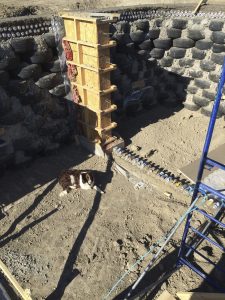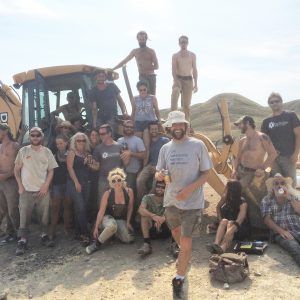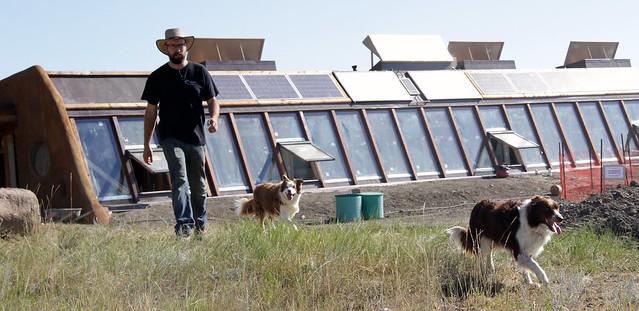By Duncan Kinney and David Dodge
When you tell people you’re building an Earthship there are two stock responses. First there are the believers. These are the people who’ve watched Garbage Warrior, twice. They want to talk design and permits and timeline. They’re into it. The other stock response is an incredulous repeating of the word back to you with a question mark attached. Earthship?
Yes, Earthship. And here’s the story of how my family built an Earthship in southern Alberta this summer.
We didn’t rush in. After first reading about Earthships in The Geography of Hope by Chris Turner I passed the book along to my dad Glen. He was intrigued so we volunteered on a build near Wheatland, Wyoming. It was invaluable seeing one built first hand and meeting other volunteers and the crew. My dad even volunteered on another build in Hundred Mile House in central B.C. the next year.
A couple years later after everything was in place my parents went down to Taos, New Mexico to check out finished Earthships first hand. Suitably convinced they came back with plans for a three bedroom, two bathroom Global Model with a couple of modifications.
Earthship roots
Michael Reynolds is the father of the Earthship movement. A draft dodger from Ohio he

The Kinney Earthship in southern Alberta. Photo David Dodge, Green Energy Futures www.greenenergyfutures.ca
ended up in Taos, New Mexico – a neo-hippy outpost on the high desert plain that’s ringed by mountains.
An architect by training and rabble-rouser by nature he was dissatisfied with standard home design and started building radically sustainable houses out on the mesa using garbage. Before recycling was a thing he was using bottles, cans and tires alongside natural and conventional building materials.
Building off-grid, self-sufficient homes out of garbage did not, at first, appeal to the Glen Kinney’s of the world. My dad has worked in oil and gas for 35 years. But for the past 20 years Reynolds has been perfecting the Earthship. And while it might sound a little wacky it has four walls, a roof, flush toilets and satellite TV just like any other North American home.

Dawn Kinney in the greenhouse, which also serves as the main hallway in the Earthship.
The design revolves around six core concepts,
- On-site electricity production
- Turning rainwater into drinking water
- On-site wastewater treatment
- Passive heating and cooling
- Food production
- Using readily available materials
An Earthship is a long skinny bungalow with an earth berm enveloping the back and sides with a greenhouse on the front. The back and side retaining walls are made of tires sledgehammered full of dirt. These tires become a 200-pound steel belt encased brick. Non-load bearing interior walls are made of aluminum cans sandwiched into a honeycomb matrix of concrete. But it’s not just the recycled materials that make it an Earthship it’s the whole package.
Solar powered, off-grid home on the prairie
It generates electricity on-site with solar panels and batteries. Drinking water is caught by the metal roof and collected in four cisterns capable of storing 5,800 gallons of water. That water is treated and filtered down to five microns to make it ready to drink. Greywater from the showers and bathroom sinks is used to water a planter in the greenhouse that is already producing a bumper crop of tomatoes. That greywater is pumped back into the house and used to flush the toilets. Simple earth tubes and ceiling vents in the greenhouse keep the house cool in the summer. Passive solar design, thermal mass, lots of insulation and southern Alberta’s glorious bounty of sunlight keep the house warm in the winter.
While we plan on installing a wood stove, Earthships maintain a consistent livable temperature through the winter by maximizing passive solar gain and incorporating a tremendous amount of thermal mass into the building.
The Earthship rises

The Earthship walls were made out of 800 tires and 12,000 cans.
We hired the Earthship crew and Michael Reynolds himself, from New Mexico to come build the house. With them came another 30-35 volunteers who camped on-site. It was an amazing experience. Eight hundred tires were pounded and stacked by the end of the fourth day. Pounding tires isn’t the easiest job, but it sure is easier with a giant crew.
Around 12,000 cans were used throughout the build for interior walls, for the bond beam that sits on top of the tires and to help fill in and pack out the tires to get them to a level surface.
In five weeks we had almost an entire house. The roof was on, the walls constructed, and the systems worked. Now we’re down to the detail work, the sanding, staining and painting. They expect to move in by November 2014.
Media interest was through the roof. The CBC, CTV, Radio-Canada, the Calgary Herald, the Lethbridge Herald all did stories. Roughly 600 people packed themselves onto our property for an open house asking questions and gawking at the systems.
What began as a radical alternative in the New Mexico desert 30 years ago has evolved into an inspiring and surprisingly simple home. And the lessons learned from Earthships can be seen today in increasingly popular net-zero homes.
People want greener, cleaner, more energy efficient housing and they’re educating themselves about it. And whether you end up redoing the insulation on your existing home or building an Earthship, it all counts. I’m excited to be back for our third season of Green Energy Futures and we hope that these stories will help you build a better future.
-30-
Michael Reynolds/Earthship Biotecture
Michael Reynolds began building homes out of recycled materials in the 1970s. His journey from rebel environmental architect to noted architect and builder of code certified homes is celebrated in the film Garbage Warrior.
He now operates Earthship Biotecture a company that trains interns and volunteers and builds Earthships all over the world.
Volunteering

The Kinney Earthship was built in 5 weeks by Michael Reynolds and his crew from Earthship Biotecture and 30 – 35 volunteers.
We had 30-35 volunteers helping us build our Earthship and their help was invaluable. The majority of the volunteers came through the Earthship Academy. It’s a course run at the headquarters of Earthship Biotecture in Taos, New Mexico. It’s a six-week class that trains students in Earthship design principles, construction methods and philosophy.
In order to complete your certificate you’re supposed to help out on a build like ours. A lot of people want to learn about how to build these homes either for themselves, as a trade or just because it’s a fun way to spend a summer. My father and I helped out on a build in Wyoming before we built ours and my dad liked it so much helped out on another build the following year.
It also means that on most builds, Earthship Biotecture has a ready-to-go pool of labour that knows their way around an Earthship.
“We have students all over the world, so if we’re going to go to Germany 50 people from Europe will come and help us. If we go South America 50 people from South America who have been in our academy will help us. So we have sort of an army that’s based all over the world and a few core crews that lead them,” says Michael Reynolds.
How to assemble an Earthship in five minutes
If you want to see a visualization of what an Earthship like ours look like piece by piece as its put together this Sketchup timelapse lays it all out.

